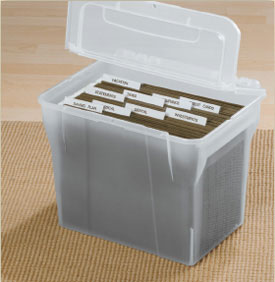
How to Organize Your Home Office – Archive Files
April 29, 2013
My last entry showed you how to better organize your appointments by giving you tips on how to make the best use of your calendar. The next area of your home office that I will help you with is your files. Given that you recently filed your taxes, I am going to focus on archiving files.
There are three main categories of files: reference, action, and archived. Archived files are reference files that you no longer need to access on a regular basis, but you need to keep for tax, legal or historical purposes. These files should be stored separately from your reference files to avoid using your “prime real estate” on documents that are seldom accessed. If you have enough file storage space in your office, you can dedicate a drawer or set of drawers to your archived files. Often times, the best location to store them is your basement. My favorite storage solution is the clear stackable plastic file box. These are inexpensive, portable, and stackable. Put your hanging files in and label the outside with ‘Archived Files’ and the subject. They can be stored in a closet, on a shelf, or even stacked on the ground. Most homes would only need one or two of these.
Past tax papers are the most common type of file archived in homes. In this example, the IRS recommends that you keep seven years of supporting documentation. Each year after you file your taxes, add the new file to your archived file box and remove the oldest file. In the event of an audit, you will be so happy that you know right where to find all the information you need. Archiving files will also maximize your file space in your home office.
Donna Lindley, Certified Professional Organizer and owner of Rochester Hills, MI-based Organize Your World, Inc